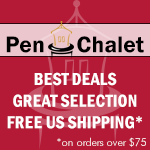(Jeff Abbott is a regular contributor at The Pen Addict. You can find more from Jeff online at Draft Evolution and Twitter.)
It might be 2017, but there's still a long stint of winter ahead for most of us. When I decided to order a bottle of Pilot Iroshizuku Fuyu-syogun, part of my reasoning was due to the wintery color of the ink. Another reason is that I haven't had any experience with gray inks of any kind. A few days later, it's in my pen and putting a smile on my face.
Being an ink from the Iroshizuku lineup, I knew to expect a well-behaved ink. I just wasn't sure about the color. Gladly, it's a very low-key blue-gray that shades nicely. It's not dreary at all. It's crisp and stoic like an early winter morning full of snow and clouds. Even though those conditions can be miserable, they can also be beautiful.
The color of Fuyu-syogun is gray with a heavy blue undertone. At times, the overall color can look like a pale, cold violet. When you look closely, it's unmistakably gray. The shading is the main reason your eyes want a second take. The blending and shifting of gray, blue, and violet make for some beautiful shading qualities. Even though the color is subdued, it stands out enough to possibly be a problem for regular office use. But, it's a tough call about how professional this ink is. It could pass in some office environments.
One minor setback for me is the lack of saturation I get in some of the lighter strokes with this ink. It's a minor complaint, and it pretty much disappears (the complaint, that is) when used in a larger or wetter nib. After trying the ink in a Kaweco EF and a Pilot F, I can say that I'll probably never use this ink in anything but a European medium nib or larger. Keep that in mind if you prefer inks with more potent saturation. Smaller nibs don't show off the nice shading this ink is capable of.
The last several inks I've tried have had relatively fast dry times. It's not something I've done on purpose, and it's not even a feature that I demand out of my inks. All the same, Fuyu-syogun dries rapidly. In my tests using a medium nib, it dried consistently between 10 and 15 seconds for normal writing. Fast drying inks are always a nice bonus.
Feathering, bleeding, and show-through are minimal with this ink. Given the light color saturation in most nibs, show-through isn't a concern for nearly any decent paper type. Even when I've tried this ink in a 1.5mm dip nib, I wasn't able to detect any feathering or bleed. Like all other Iroshizuku inks, it's well-behaved and predictable in this sense.
I ordered this ink from JetPens, and it's one of the Iroshizuku lineup that come in two sizes: 50ml or 15ml. I've recently been on a small bottle kick because of how easy they are to store. And even though 15ml is a lot less than 50ml, it still goes a long way in fountain pen terms.
This is a great ink, and a permanent favorite for me. It's my first gray ink experience, and I'm glad it's a positive one. If you're looking for a neutral, slightly-blue gray ink to try, give this one a look. With gray inks, you can choose from many different shades (from cold to warm, blue to brown), but this is a great place to start.
(JetPens provided this product at no charge to The Pen Addict for review purposes.)
Enjoy reading The Pen Addict? Then consider becoming a member to receive additional weekly content, giveaways, and discounts in The Pen Addict shop. Plus, you support me and the site directly, which I am very grateful for.
Membership starts at just $5/month, with a discounted annual option available. To find out more about membership click here and join us!
































